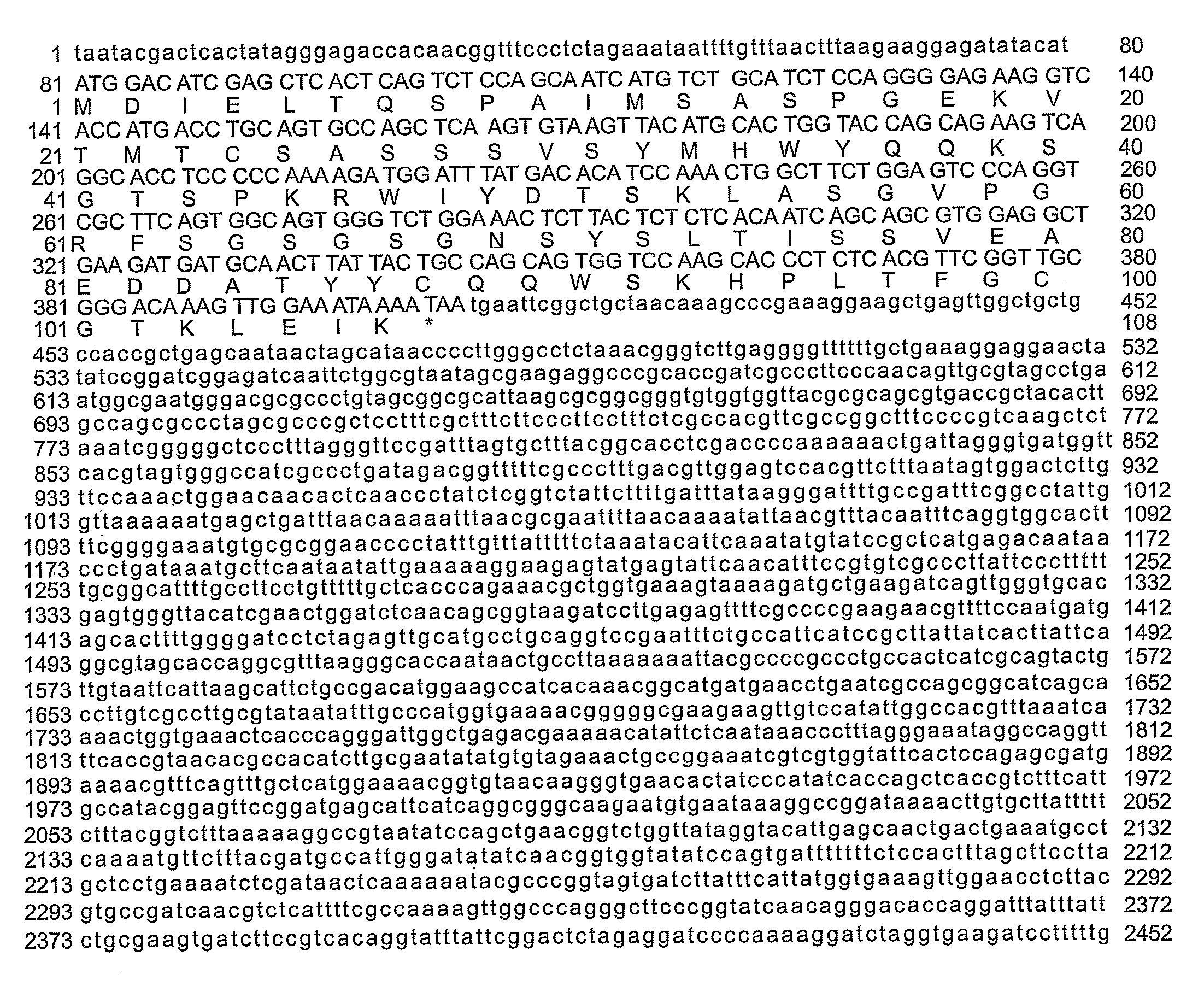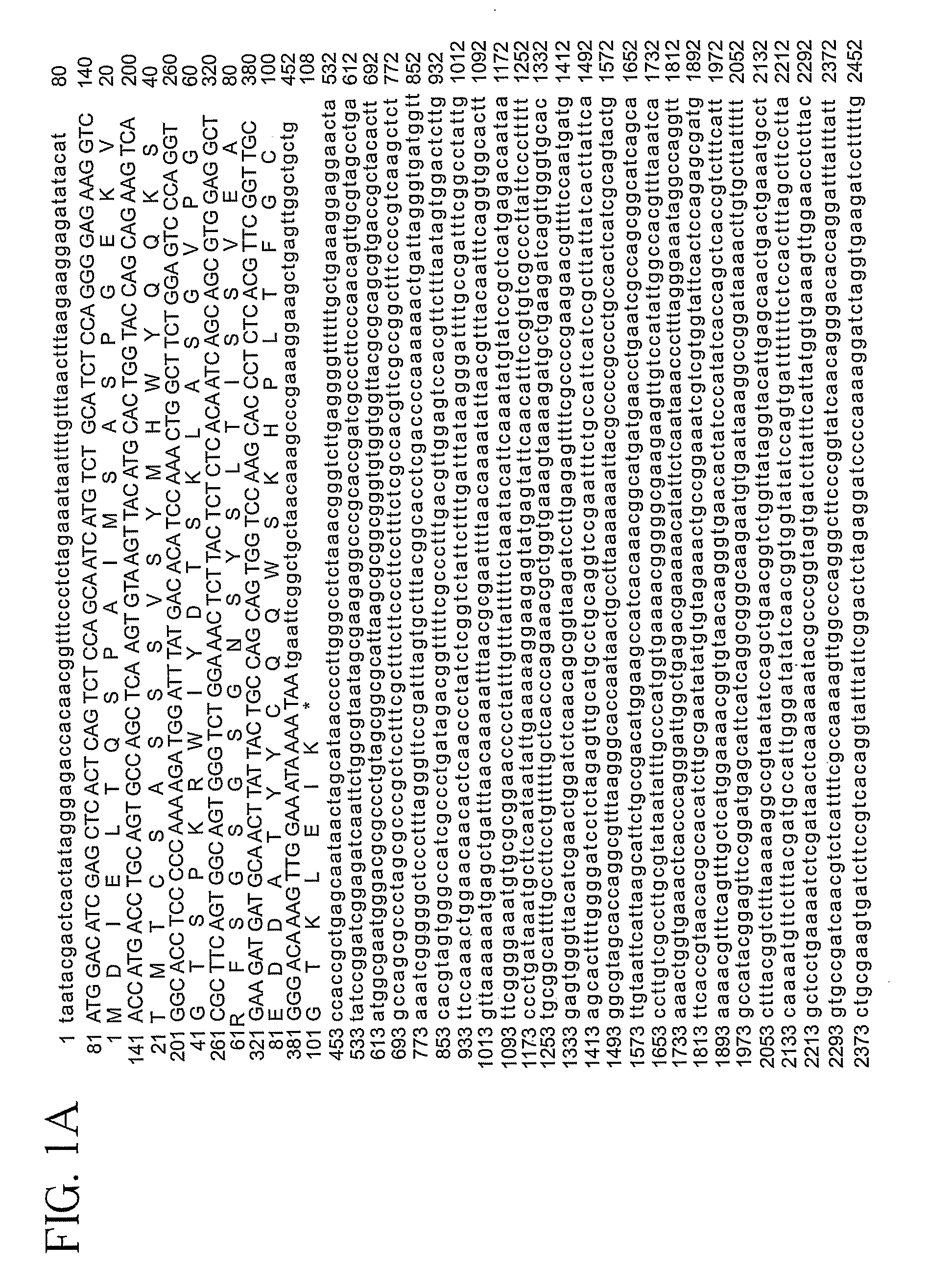Polymer-Linked Pseudomonas Exotoxin Immunotoxin
a technology of exotoxin and polymer-linked pseudomonas, which is applied in the field of polymer-linked pseudomonas exotoxin immunotoxin, can solve the problems of difficult selective targeting of tumors and tumor cells while avoiding significant damage to healthy cells and tissues, poor tissue penetration, and previous attempts generally not satisfactory
- Summary
- Abstract
- Description
- Claims
- Application Information
AI Technical Summary
Benefits of technology
Problems solved by technology
Method used
Image
Examples
example 1
Preparation of Recombinant Immunotoxin
The Expression Vectors
[0151]The SS1P immunotoxin was constructed as a disulfide-linked (“ds”) dimer. Each of the two components was separately expressed, isolated and renatured under conditions promoting ds dimer formation.
[0152]BL21(DE3) / pPSC7-7 cm Cell Line
[0153]The anti-mesothelin heavy chain variable domain (“SS1-PE38VH”) was expressed in culture by BL21(DE3) host cells containing a pPDC7-4 cm plasmid (FIG. 1; SEQ ID NO:1). This is the BL21(DE3) / pPSC7-7 cm cell line. The DNA molecule encoding the SS1-PE38VH polypeptide is according to SEQ ID NO: 6, and the SS1-PE38VH polypeptide sequence is as follows.
(SEQ ID NO: 5)MQVQLQQSGPELEKPGASVKISCKASGYSFTGYTMNWVKQSHGKCLEWIGLITPYNGASS 60YNQKFRGKATLTVDKSSSTAYMDLLSLTSEDSAVYFCARGGYDGRGFDYWGQGTTVTVSS120kasggpeggslaaltahqachlpletftrhrqprgweqleqcgypvqrlvalylaarlsw180nqvdqvirnalaspgsggdlgeaireqpeqarlaltlaaaeserfvrqgtgndeagaang240padsgdallernyptgaeflgdggdvsfstrgtqnwtverllqahrqleergyvfvgyhg300tfleaaqsivfggvrar...
example 2a
Culture of the E-Coli Expression Vectors
[0156]The BL21(DE3) E. coli strain carrying the plasmid expression vector containing cDNA of SS1-PE38VH was grown at 37° C., in Superbroth medium supplemented with kanamycin (10 μg / ml) and chloramphenicol (25 μg / ml) in batch culture in a 5L fermenter with 4.5 L of medium for 5-6 hours until the density reached an OD600 value of 5-8. Cells were then induced with 5 mM IPTG for 1.5 hours. Grown cells containing the expressed SS1(dsFv)-PE38 immunotoxin and SS1VL were harvested by centrifugation in a Beckman centrifuge (model Avanti J-20I, Fullerton, Calif.) using a JLA8.1000 rotor for 20 minutes at 4° C. at 7000 rpm. A typical yield was from 15-20 g (wet weight) of cells per liter of culture fluid.
[0157]The BL21(DE3) E. coli strain carrying expression vector containing cDNA of SS1-VL was grown a 7° C., in Superbroth medium supplemented with kanamycin (10 μg / ml) and chloramphenicol (25 μg / ml) in batch culture in a 5L fermenter_with 4.5 L of medium ...
example 2b
Purification of SS1P Proteins from Cultured E. Coli
[0158]SS1(dsFv)-PE38 was expressed in E. Coli host cells cultured as described above and purified by the following method.
1. Reagents and Buffers
[0159]The following reagents were employed in the purification of the SS1P immunotoxin from cultured host cells.
[0160]Lysozyme; dithioerythritol (DTE); glutathione, oxidized form (GSSG); L-arginine-HCl; Triton X-100; urea; 0.1 N, 1N NaOH.
[0161]Sterile solution: 1 M Tris-HCl, pH 7, 4; 1 M Tris-HCl, pH 8.0; 0.5 M EDTA, pH 8.0; 5 M NaCl; PBS (1X) without calcium and magnesium.
[0162]The following buffers were employed in the purification of the SS1P immunotoxin from cultured host cells.
TES BufferTE 50 / 20 Buffer50 mM Tris-HCl,50 mM Tris-HCl,pH 7.4pH 7.420 mM EDTA20 mM EDTA100 mM NaClSolubilization bufferRefolding buffer6 M Guanidine-HCl0.1 M Tris0.1 M Tris-HCL, pH 8.00.5 M L-arginine-HCl (105 g / L)2 mM EDTA2 mM EDTA
[0163]The refolding buffer was prepared as follows. The pH was adjusted to 10.5 wi...
PUM
| Property | Measurement | Unit |
|---|---|---|
| Atomic weight | aaaaa | aaaaa |
| Atomic weight | aaaaa | aaaaa |
| Molar density | aaaaa | aaaaa |
Abstract
Description
Claims
Application Information
 Login to View More
Login to View More - R&D
- Intellectual Property
- Life Sciences
- Materials
- Tech Scout
- Unparalleled Data Quality
- Higher Quality Content
- 60% Fewer Hallucinations
Browse by: Latest US Patents, China's latest patents, Technical Efficacy Thesaurus, Application Domain, Technology Topic, Popular Technical Reports.
© 2025 PatSnap. All rights reserved.Legal|Privacy policy|Modern Slavery Act Transparency Statement|Sitemap|About US| Contact US: help@patsnap.com



